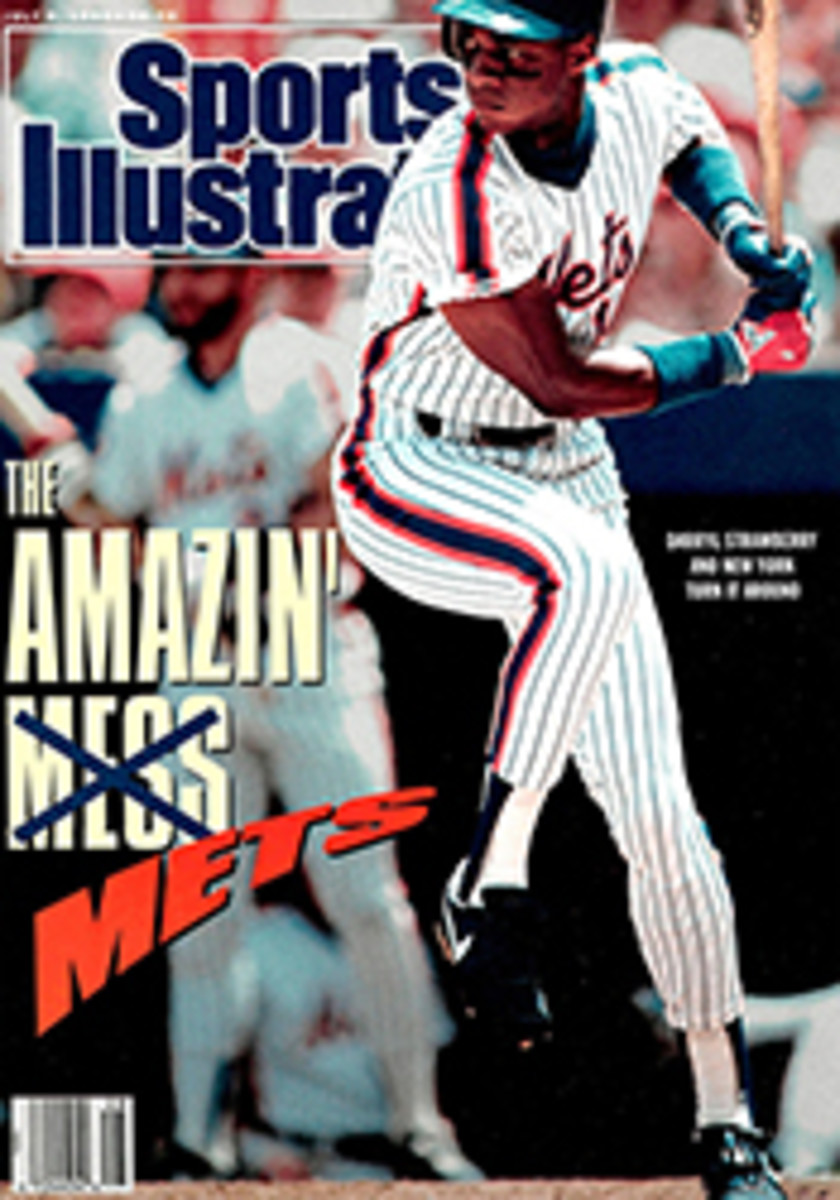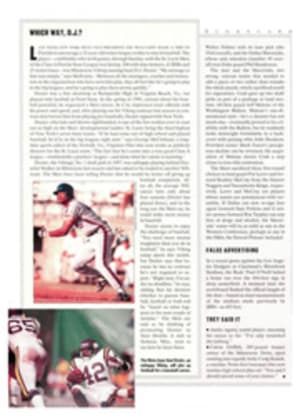
GOOD PLACE TO GO BATTY
"Last Saturday was absolutely classic," Sharon Oberriter was saying. "We had this little boy come to the door with his parents, and he sees everything and says, 'Oh, boy! Bats!' He ordered his bat and five minutes later, he's outside still saying, 'Oh, boy! Bats! Oh, boy! Bats!'
"Then 10 minutes later, two grown men come into the store and one of them says, 'Oh, boy! Bats!' It was exactly the same reaction, except there was 30 years' difference in age between the little boy and the adult. And that is what is so wonderful. You see grownups who genuinely let go and enjoy it."
It's been that way since 1981, when Sharon, 47, and her husband, Don, 52, opened the Cooperstown Bat Company in a converted garage not far from the Baseball Hall of Fame in Cooperstown, N.Y. Inside there are hundreds of bats, some stuffed into long cardboard boxes, others hanging from special wooden racks. All have been hand-finished by the Oberriters, and all have a pristine, glossy look. But what sets these bats apart from your everyday bats are the multicolor lettering, designs and portraits that embellish them. These bats aren't for hitting, they're for hanging.
Some of the bats simply read: COOPERSTOWN HOME OF BASEBALL in fire-engine-red letters. But the series on old ballparks really catches the eye. Images of Wrigley Field, Fenway Park, Forbes Field, Ebbets Field and the Polo Grounds are emblazoned on the barrels of the bats by a chemical process the Oberriters have developed. "As far as we know, no one has been able to do what we do," Sharon says.
The latest venture by the couple is a famous-player series. Pee Wee Reese and Ted Williams bats have already gone into production and one new player-bat series will be produced annually. Reese and Williams autographed 1,000 of the bats bearing their images and, almost instantly, the limited edition souvenirs became hot items in the collectors' market.
Cooperstown never has been, and probably never will be, on the way to anywhere. And even if you are one of the quarter-million people who visit the Baseball Hall of Fame each year, you might easily miss the Cooperstown Bat Company. A two-by three-foot sign outside the basement garage is the only indication of an office. That may strike some as an unlikely way to run a business, but the conversion of the Oberriters from small-town restaurateurs to big-time bat producers is far more unlikely.
Don has not attended a major league game in 15 years. Sharon has never been to one. Neither has much of a background in the lore and legend that absorb Cooperstown.
The Oberriters moved there in 1976 from Utica, N.Y., to get away from the pressure of running a family restaurant that had grown from being a comfortably busy operation into an all-consuming monster. In Cooperstown, which has a year-round population of 2,500, they opened a small restaurant specializing in sandwiches. "All I wanted to do was run a nice restaurant and not get an ulcer," Don says.
"Cooperstown was much quieter then," Sharon says. "It was a little sleepier, a little more like it had been for the preceding 150 years. You worked hard all summer to put money in a savings account so that the money would stretch to the next season."
But by the late '70s, Don was getting restless. He decided to establish a restaurant with a baseball motif to take advantage of the growing Hall of Fame tourist trade. He would call the eatery the Cooperstown Bat Company and, in order to legitimize its name, the restaurant would sell bats as souvenirs.
"Literally, Don woke up one night and told me we were going to make bats. I told him he was bats," Sharon says.
The Oberriters developed a logo and had it trademarked. They began by offering a line of Little League bats that sold for $9.95 each (an extra $1.50 if you wanted Sharon to personalize it with a name or message in indelible ink). At first, the Oberriters thought they could make the bats themselves. But after frustrating hours working raw wood billets on a lathe, they were otherwise convinced. "There were a lot of bats that never saw the light of day," Don says. Eventually, they came to the conclusion that they were best at finishing the bats, not making them from scratch. Today, all their bats are purchased from major bat manufacturers.
"There are a number of ways to put information on a bat," Sharon explains, "and we looked at all of them. But to achieve what we wanted to achieve, it has to be done by hand. We found no way to automate what we do. We found no way to change the method we use that would give us better range or reproduction quality. So, at least for the moment, we're doing the only thing possible for what we wanted to achieve on bats."
What the Oberriters do sounds easy enough. The images of the ballparks and players are executed by Bruce Guyot, a local artist, then printed in reverse on a special paper and transferred to the uneven surfaces of the blank bats. That's all there is to it, though developing the right decal techniques took four years of experimentation before the Oberriters were satisfied enough to start selling the bats in 1982.
Just as Don had hoped, visitors to the Hall of Fame liked the bats and began buying them. What the Oberriters did not envision was the explosion in the baseball collectibles field that hit about the same time their bats went on the market. The bat portion of the company quickly became the main part of their business, and in 1988 the Oberriters sold the restaurant to devote full time to bats.
"We know our product goes up in value the moment it walks out the door," Sharon says. "But we are not going to create an inflation of value [by changing production runs, or holding bats off the market]. We are not interested in contributing to a manipulation of the market value."
So out the door the bats go, the stadium series bats at $45 each, the famous player series for $195 to $275 each. The collectors continue to snap them up, and the baseball memorabilia dealers know it.
At a baseball card show in Albany, N.Y., last year, John Convent, a dealer from Worcester, Mass., displayed several stadium models. A Yankee Stadium bat with a Reggie Jackson autograph carried a tag of $450. A Polo Grounds bat with a Willie Mays signature was selling for $225.
"A blank bat [without an autograph] will go for eight or nine times the original price," Convent said. "Honestly, I don't like to part with them. That's why I price them so high. I have a Yankee Stadium bat at home with a Mantle autograph. I won't part with that."
The Oberriters would prefer that their bats be appreciated simply for the craft and the nostalgic tribute they embody. "We're just concerned about making a good product at a fair price and making it available to people who would like it," Sharon says. "Dealers are dying to get hold of our stuff, and have been for years. We don't have a dealer network. There are dealers who do business with us, but they do business in the same fashion that customers do business with us."
A customer is limited to three bats per order. The bats can be purchased only in Cooperstown or by mail order. Last year, the entire stock of 6,600 bats was exhausted by August. This year, the Oberriters expect to produce 7,200 bats. Even after a contemplated new facility is in place in 1991, Don estimates that the company's total annual production will not go above 15,000 bats.
While production is limited because of the bats' hand-crafted quality, the number of future projects for the Cooperstown Bat Company is not. "This type of business will have no cap," Sharon says. "As long as the game remains in motion, as long as there is baseball and new players, there will be a Cooperstown Bat Company."
"When you get to be 50 years old, you begin to wonder what's your little mark on the world," Don says solemnly. "I am of the opinion that in 30, 40 years our product will be one of the most sought-after pieces of this era. The goal I have had is to make a product that, with a little bit of care, will last 50 to 100 years.
"When I'm working on these things—and it can be very monotonous, very repetitious work—and I blow one and have to clean the bat down and start over again, I need the motivation of pride to finish that particular bat. Somewhere down the line, I still want to be proud that I did it."
The Oberriters get that feeling anew every time the door to their salesroom opens and a wide-eyed baseball fan says, "Oh, boy! Bats!"
PHOTO
LANE STEWART
Sharon and Don Oberriter began making bats to build business. Now bats are the business.
PHOTO
LANE STEWART
The secret of the Cooperstown bats is the process by which the custom decal is applied.
PHOTO
LANE STEWART
Several series are in production: (from top) ballparks, legendary players and team bats.
Ken Tingley is sports editor of "The Post-Star" in Glens Falls, N.Y.

